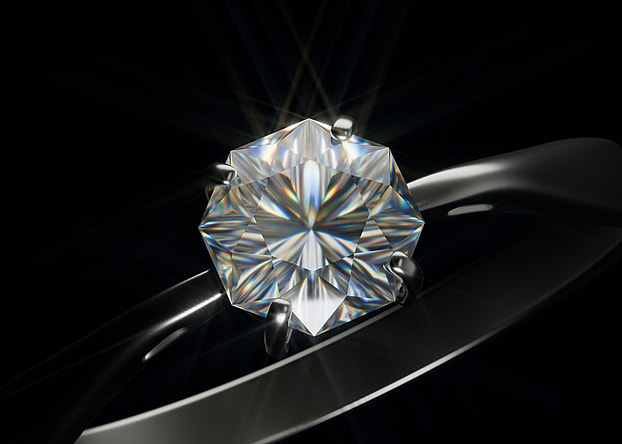
So, how are diamonds made? For generations, people have been captivated by diamonds, known as “the king of gemstones,” and their allure has lasted for centuries. They represent love, prestige, and luxury in addition to being precious stones due to their brilliance, clarity, and timeless appeal.
The journey of a diamond, from its formation deep below the Earth to its ultimate placement in jewelry, is a monument to the extraordinary natural processes and human workmanship involved in producing these precious gems when you’re wondering how are diamonds made. Diamonds are the product of a complex interaction between geological, technological, and commercial forces that shapes their journey from the depths of the Earth to the jewelry display cases around the world, despite their seeming simple beauty.
Diamonds’ attractiveness stems from their rarity and the intricate procedure that goes into their formation. Natural diamonds have special optical and physical qualities because they are formed under extremely high and low pressure. But thanks to developments in technology, the production of diamonds is now not limited to natural processes of how are diamonds made. Innovative methods used to manufacture lab-grown diamonds provide a sustainable substitute for conventional mining, opening up new opportunities for both customers and the industry.
It is necessary to take a close look at each step of a diamond’s journey in order to comprehend its entire existence, from formation to ultimate destination. This covers the natural processes that lead to the development of diamonds, the sophisticated techniques used in their mining and extraction, the painstaking skill involved in their cutting and polishing, the emergence of lab-grown diamonds, and the convoluted supply chain that gets them to consumers. We can obtain a thorough understanding of how are diamonds made and the complex nature of these wonderful gemstones by delving into these facets.
We shall look closely at each step of a diamond’s development and travel in this post. We will begin by discussing how are diamonds made naturally and how mining techniques raise them to the surface. Next, we’ll examine the cutting and polishing procedures that turn unpolished diamonds into polished jewels. The evolution of lab-grown diamonds and their effects on the market will be discussed next. Lastly, we will talk about retail and distribution, emphasizing the consumer marketing and sales of how are diamonds made. This investigation will cover ethical and environmental issues in the diamond business in addition to illuminating the scientific and technological aspects of diamond manufacturing.
Read More: Did the World’s Rarest Whale Wash Up on a beach in New Zealand?
The Natural Formation of Diamonds

Diamonds are a unique gemstone with a strong physical structure that are created under extreme conditions in the Earth’s mantle. The interesting interaction of geological forces that takes place far below the Earth’s surface, where most life forms and human activity do not exist, is what gives rise to the diamond production process. Knowing this natural process helps explain how are diamonds made, why diamonds are so valuable, and why the process of creating them is a unique and complicated occurrence.
1. The Geologic Process
The mantle, a zone located 100 miles (160 km) below the Earth’s surface, is where diamonds are first formed. Extreme temperatures and pressures surpassing 2,000 degrees Fahrenheit (1,093 degrees Celsius) and 725,000 pounds per square inch (5 gigapascals) are applied to carbon atoms in this environment. When wondering how are diamonds made, carbon atoms form bonds in a crystalline structure called a diamond lattice when certain conditions are met. The hardness and brilliance of diamonds are attributed to this lattice.
Deep under the Earth’s mantle, where it has been exposed to heat and pressure for millions of years, is the carbon that makes diamonds. The first step in the formation process is the transformation of carbon atoms into crystalline structure. This happens in graphite, a type of carbon that has reorganized itself into the stable diamond structure.
2. Volcanic Eruptions and Kimberlite Pipes
Volcanic eruptions carry diamonds from their place of formation to the Earth’s surface. How are diamonds made? Diamonds go from the mantle to the surface through kimberlite, a form of volcanic rock that is brought to the surface by these eruptions. Diamonds are mostly found in kimberlite pipes, which are vertical channels created by volcanic activity and used in mining activities.
Kimberlite pipes are the result of unusual, irregular volcanic eruptions. Because of this, concentrated amounts of diamonds are frequently discovered inside these pipes. Once the kimberlite is exposed to the elements, it may gradually disintegrate and disperse diamonds into the nearby sedimentary formations.
3. Alluvial Deposits and Erosion
Diamonds can be found in alluvial deposits in addition to volcanic eruptions. These are sedimentary deposits that were created when diamonds were carried by rivers and streams and eroded kimberlite pipes. Diamonds are transported from their original source over time and end up in riverbeds, floodplains, and coastal regions.
In alluvial mining, if you’re wondering how are diamonds made, they are extracted from these sedimentary deposits by sifting through dirt and gravel. Although less invasive than conventional mining, this approach still needs to be carefully processed to remove the diamonds from other elements. Although the geological history of the region frequently influences the formation of alluvial deposits, they can be rich in diamonds.
4. Diamond Mining: Methods and Techniques
There are various techniques used in how are diamonds made from the Earth, and each is appropriate for a particular kind of deposit. These techniques include alluvial mining, open-pit mining, and underground mining. Each has unique difficulties and environmental concerns.
a. Open-Pit Mining: In situations where diamonds are found near the surface of the Earth, open-pit mining is employed. Using this procedure, a lot of rock and dirt must be removed in order to reach the ore that contains diamonds and how are diamonds made. Although it necessitates a lot of excavation and heavy machinery, the method makes it possible to harvest diamonds from huge deposits effectively.
b. Underground Mining: Underground mining techniques are used for resources that are deeper. This process entails digging shafts or tunnels to reach ore that contains diamonds. Because underground mining requires specific equipment, ventilation systems, and safety precautions, it is more complicated and costly. Nonetheless, it makes it possible to recover diamonds from reserves that are deeper and inaccessible by open-pit mining.
c. Alluvial Mining: How are diamonds made? Diamonds are extracted by alluvial mining from sedimentary deposits and riverbeds. Using this technique, diamonds must be separated from other elements by sifting through gravel and soil. Alluvial mining is less invasive than open-pit or underground mining, but it still needs to be processed carefully to guarantee effective diamond recovery.
5. Environmental and Ethical Considerations
The diamond mining sector is confronted with substantial ethical and environmental issues. Water contamination, soil erosion, and habitat destruction are just a few of the negative consequences that mining operations can have on ecosystems. Degradation of the environment can also result from the use of chemicals and large gear in mining operations of how are diamonds made.
The topic of conflict diamonds—stones mined in conflict areas and sold to fund armed conflict—is one of the ethical issues surrounding the diamond industry. In order to solve this problem, the Kimberley Process Certification Scheme was created, which controls the diamond trade and guarantees that the stones come from conflict-free regions. Still, there are obstacles to overcome, and the sector is always looking for better ethical and ecological methods.
Also Read: What is the Oldest Tower in the World? A Fascinating Structure
Cutting and Polishing: The Art of Craftsmanship

After being extracted from the earth, diamonds are carefully cut and polished to turn them from rough stones into brilliant gems. To optimize the diamond’s brilliance and value, this phase of its journey involves both art and science, demanding dexterity and talent.
1. Diamond Cutting
To improve the rough diamond’s beauty and value, it is shaped into a certain shape during the cutting process. In order to maximize the diamond’s optical qualities, the internal structure must be evaluated and strategic cuts must be made. To optimize the diamond’s brilliance, facets that reflect and refract light are to be created.
a. Cleaving and Sawing: Cleaving or sawing the rough diamond into smaller pieces is the first step in the cutting process. While sawing divides the stone into smaller pieces using a saw with a diamond point, cleaving entails separating the diamond along its inherent crystal planes. To reduce material loss and guarantee the quality of the diamond, this phase needs to be carefully planned.
b. Faceting: The technique of faceting a diamond involves forming flat surfaces, or facets, to increase its brilliance for how are diamonds made. In order to maximize light reflection and refraction, each facet is precisely oriented. The round brilliant cut, which has 58 facets and is intended to enhance the brilliance of the diamond, is the most popular cut. Other well-liked cuts with distinct qualities are the princess, emerald, and cushion cutting.
2. Polishing
The diamond is polished after cutting in order to brighten its luster and remove surface imperfections. How are diamonds made? The diamond is polished by rubbing it up against a revolving wheel covered in a fine abrasive. Repeating this technique several times yields a great degree of clarity and sparkle.
a. Polishing Stages: To obtain a smooth and glossy surface, polishing is usually done in numerous stages, employing progressively finer abrasives in each step. To give the diamond its last brilliance, a polishing paste is applied in the final step. In order to make sure that the diamond satisfies the required quality standards, the lapidary, or diamond polisher, must be skilled.
b. Quality Assessment: Following polishing, the diamond’s quality is evaluated using the four Cs: carat weight, color, clarity, and cut. Gemologists assess these characteristics to ascertain the diamond’s worth and appropriateness for jewelry.
Read More: What’s the Most Expensive Hotel in the U.S.?
Lab-Grown Diamonds: A Modern Alternative

Lab-grown diamonds have been a major breakthrough in how are diamonds made in recent years. These diamonds are produced by sophisticated technical methods that mimic the environment in which diamonds naturally occur. Lab-grown diamonds provide new opportunities for customers and the industry by providing a more ethical and sustainable alternative to traditional mining.
1. Methods of Lab-Grown Diamond Production
a. High Pressure High Temperature (HPHT): The severe conditions present in the Earth’s mantle are replicated by the HPHT method. Diamonds are created in a laboratory setting by applying high pressure and temperature to carbon. Natural diamonds and HPHT diamonds have the same hardness and brilliance both chemically and physically.
b. Chemical Vapor Deposition (CVD): The CVD process uses a vacuum chamber to create diamonds from a combination of gasses. When carbon-containing gasses are ionized, a plasma is created that progressively deposits carbon atoms on a substrate to create diamond crystals. CVD diamonds are manufactured in a variety of hues and sizes and are renowned for their excellent quality.
2. Benefits and Challenges
Diamonds created in laboratories have various benefits, such as less environmental impact and ethical sourcing. Since mining is not involved, worries about conflict diamonds and habitat devastation are allayed for how are diamonds made. Furthermore, compared to natural diamonds, lab-grown diamonds may be manufactured more quickly and frequently for less money.
However, there are issues with consumer perception and market acceptance regarding lab-grown diamonds. Although they resemble real diamonds in both appearance and composition, customers frequently have diverse opinions about them and how are diamonds made. It is imperative that the general public be made aware of the advantages and characteristics of lab-grown diamonds in order to increase their market adoption.
Read More: 7 Old World Maps People Thought Were Genuine
Distribution and Market Dynamics

A diamond travels through a complicated distribution network from the time of its creation to its ultimate destination. The price and availability of the gemstone are determined by the many steps of processing, distribution, and retail that are included in this network.
1. Distribution Network
a. Wholesalers and Dealers: Diamonds are sold to wholesalers and dealers who serve as middlemen between producers and retailers after being cut and polished for how are diamonds made. These organizations buy diamonds in bulk and supply jewelry producers and merchants. Dealers and wholesalers are essential to controlling the supply chain and guaranteeing that diamonds are delivered to the market effectively.
b. Jewelry Manufacturers: Diamonds are used in the design and creation of jewelry by jewelry producers. They choose their diamonds according to their cut, size, and quality, then set them into a variety of jewelry pieces, including necklaces, earrings, and rings. In order to meet design standards, the jewelry settings must be crafted, the diamonds must be placed, and the final product must be finished.
c. Retailers: Retailers sell diamond jewelry to customers as the last link in the supply chain. They might run internet portals, physical storefronts, or both. Retailers frequently accommodate varied consumer tastes and budgets by offering a variety of diamonds with varying grades and pricing points. The retail industry is a major influence on the attitudes and tastes of consumers.
2. Market Trends and Consumer Preferences
Numerous developments and consumer preferences have an impact on the diamond market. The demand for diamonds is influenced by a number of variables, including prevailing economic conditions, fashion trends, and technological developments in how are diamonds made. For instance, demand for lab-grown diamonds and other alternatives to conventional mining has surged due to the growing appeal of morally and environmentally conscious goods.
a. Fashion and Design Trends: Trends in jewelry design and clothing have a significant impact on the market for diamonds. Shifts in customer tastes for particular cuts or settings can have an effect on the kinds of diamonds that are in demand.
b. Economic Conditions: The diamond market may be impacted by economic variables like shifts in the world economy and consumer buying trends. The desire for luxury goods like diamonds may decline during uncertain economic times, but consumer expenditure on expensive jewelry may rise in times of economic expansion.
3. Pricing and Valuation
A number of factors influence diamond prices, including the four Cs: carat weight, color, clarity, and cut. Gemologists assess these qualities and how are diamonds made, which have a big impact on how much a diamond is worth. Price is also affected by supply and demand, market circumstances, and production costs.
a. Carat Weight: The diamond’s size is indicated by its carat weight. Although larger diamonds are more expensive per carat, other elements like color, clarity, and cut can also affect the price.
b. Color: Diamonds range in color from D, which is colorless, to Z, which is pale yellow or brown. Less colored diamonds are usually more costly since they reflect and sparkle more light.
c. Clarity: The existence of inclusions, defects, and imperfections, whether internal or exterior, is referred to as clarity. Less imperfect diamonds are more valuable because they have more sparkle and aesthetic appeal.
d. Cut: A diamond’s brilliance and sparkle are determined by its cut. Exact facets and angles on well-cut diamonds reflect light well, adding to their total beauty and value.
Read More: 6 Most Expensive Perfumes on the Market
How are Diamonds Made?

From their natural development deep under the Earth to their transformation into polished gems and delivery to consumers, the production and journey of diamonds show an amazing and complex process of how are diamonds made. Comprehending the process of diamond creation offers valuable understanding of the scientific, ethical, and commercial facets of the diamond sector. Each step adds to the significance and appeal of these priceless stones, from the difficulties of mine and the cutting artistry to the developments in lab-grown technology and the difficulties of distribution in how are diamonds made.
As the diamond business develops and grows, we learn important lessons about how to strike a balance between sustainability, ethical concerns, and aesthetic appeal. Diamonds continue to be a representation of human ingenuity and desire, whether they are produced via conventional mining techniques or cutting-edge lab-grown techniques. They represent our passion for the natural world and our pursuit of master workmanship for how are diamonds made. The diamond business can adapt to the shifting requirements and values of consumers while maintaining the beauty and significance of these timeless gemstones through ongoing innovations and sustainability-focused activities.


